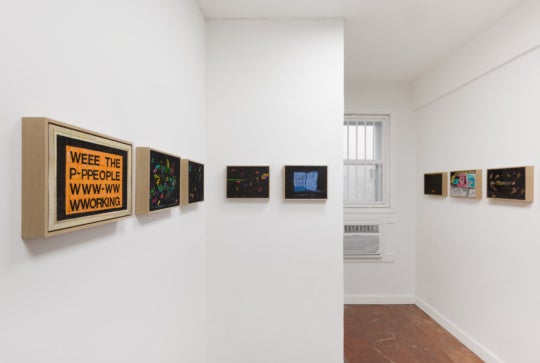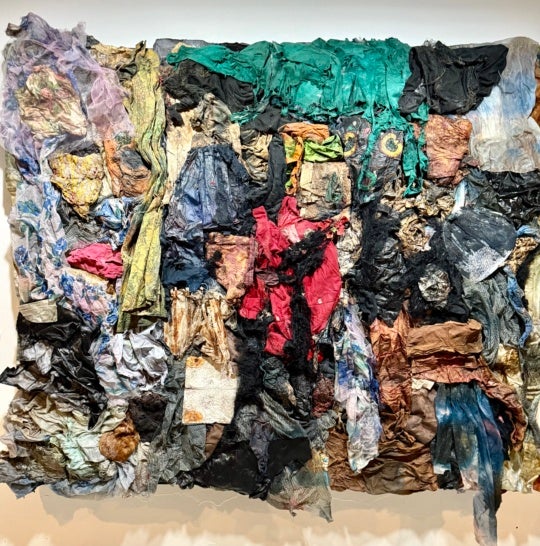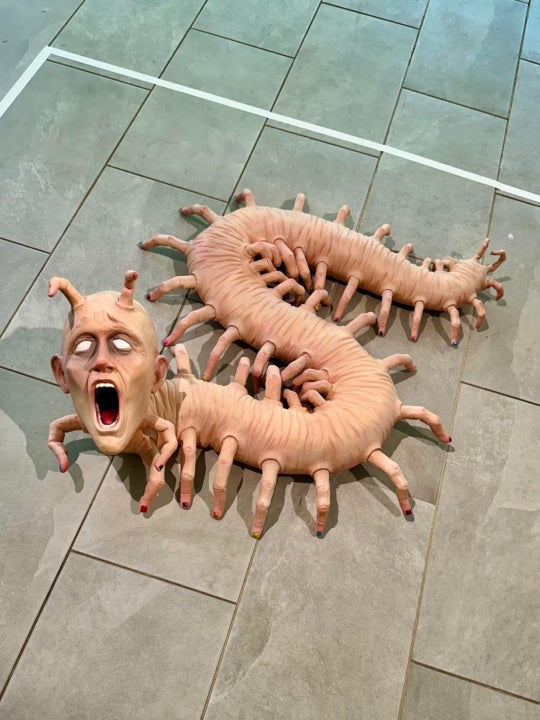
The opportunity to see experimental, silent, and independent work on film is a rarity these days, even in a city like New York, but Atlanta is a unique exception, thanks to the vision of Andy Ditzler. A steadfast advocate for this vanishing medium, Ditzler is the curator of “Film Love,” a series he has been operating since 2003 at Eyedrum and other exhibition spaces in Atlanta. His programming has largely focused on the historic avant-garde with evenings dedicated to works by Joseph Cornell, Jack Smith, Stan Brakhage, Chantal Akerman, and others. At the same time, Ditzler is interested in showcasing contemporary filmmakers and new work, such as the observational documentaries of Anna Grimshaw (Mr Coperthwaite: A Life in the Maine Woods, Parts 1-4).
With more than 120 programs to his credit, Ditzler still strives to host one “Film Love” screening each month, but in February he’ll treat Atlanta audiences to two uniquely different events. On Feb. 21 at the Atlanta Contemporary Art Center, he will present “The Velvet Underground,” a cinematographic tribute to the Velvet Underground, musician Lou Reed (1942-2013), and the relationship with their mentor and producer Andy Warhol.
This will be followed by “The 1960s films of Jan Nêmec” on Feb. 28 – March 4. Presented in conjunction with Emory University, this three-film salute to the Czechoslovak New Wave director includes the 1964 surrealistic drama Diamonds of the Night (in a new 35mm print), the political allegory A Report on the Party and the Guests (1966), and Martyrs of Love (1967), a trio of satiric fantasies. In a recent interview at his Grant Park home, Ditzler discussed these upcoming programs and their importance.
Jeff Stafford: I know that “Film Love” champions the lost art of film projection, but does that also mean you refrain from programming video or digital works?
Andy Ditzler: No, I show them in whatever way I have to. That’s my base attitude, but showing them in the medium that the filmmaker preferred is paramount. I also happen to think it’s better. I can’t speak to the technical aspects of why film projection would be better than video projection, but I do know that there’s a magic to film projection that is quite appealing. The sensory aspect of film projection is so much of the enjoyment. You’re pulling down the screen. You’re threading the projection. This is just how it’s done. It’s not just about threading the film and the technical details, but sitting by the projector, being in that position in the room, seeing the audience. It’s colored my entire moviegoing experience over the past decade. That said, I also show recent work that originated in video, like Anna Grimshaw’s. The series is about the moving image in general.

JS: Regarding your Andy Warhol/Velvet Underground program, film seemed to play an important part in the Velvets’ earliest live appearances.
AD: Film projection was not ancillary to their performances in the beginning; it was actually central. They first became known as a kind of house band for underground film screenings, and their first performances with Warhol heavily incorporated his films. The Velvets came into Warhol’s orbit right at the time he was moving into expanded cinema and double screen projections. He made the film The Velvet Underground and Nico in January of ’66, barely two months after they met. And there’s another one made around the same time called simply The Velvet Underground. I’m going to show both.
JS: The Velvet Underground and Nico is unusual because it starts out like a filmed rehearsal but transitions into something entirely different.
AD: That’s the interesting thing about the film—the ambiguity between rehearsal and performance. I’ve been calling it a rehearsal film, but to some extent it’s a performance and the line is not exactly clear, which is one of the great things about it and, of course, characteristic of Warhol.

JS: Warhol’s early films were often criticized as static, with no discernible directorial focus.
AD: The really interesting thing about Warhol is exactly what’s interesting about all his other artwork, which is that the more it seems like nothing’s going on, the less you can pin him down. When you realize that, there is so much going on and so much of it is what you bring to it as a viewer. That’s not laziness on his part, that’s a freedom that he gives a viewer. That’s a very, very revolutionary thing to do in cinema. What’s often cast as a kind of shallow consumerism is actually a gesture of openness and freedom toward the viewer in which one discovers one’s self. There is no more generous kind of filmmaking than that, but you do have to meet it halfway. And that’s the challenge. People who aren’t prepared to do that are going to experience it as boredom.
JS: For someone who has never seen any Andy Warhol films before, how would you prepare them for the experience?
AD: If you just look at the six months from late ’63 to summer ’64, which comprised the bulk of his silent filmmaking, he’s involved in a search for what is the essence of a cinematic medium. He approaches that question by steadily removing things. He begins with Eat, Blow Job, and the screen tests. He removes sound. With Haircut he starts removing editing and any kind of narrative interest. He removes motion because the Empire State building [film] is the culmination of this: a single, stationary, unmoving shot. Finally, he removes light because Empire is filmed almost entirely at night, almost entirely in darkness. It’s a gradual process of removal. What can you remove and still have cinema?
After this, he goes into sound filmmaking and starts adding back in. Warhol’s sound films are amazing, full of brilliant spots and lulls and occasional irritation and just when you think you’ve had enough—pow! something truly surprising happens. Almost all the Warhol films I’ve seen have at least one moment, and sometimes more, where the whole thing breaks down—the actors just decide that the film is done, or get too far into their role-playing and have to be calmed down, or the police walk in—and Warhol keeps the camera running. It’s quite magical; the line between performance and life breaks down in front of your eyes, but it happens on camera, so that means the line between cinema and life breaks down too, if you let it. No one else worked this way so fruitfully. Just because he didn’t know what would happen when the camera was running doesn’t mean he didn’t know exactly what he was doing.
JS: Your other “Film Love” program in February showcases another key filmmaker from the ’60s, Czech director Jan Nêmec. Why did you choose him?
AD: You watch these films and immediately recognize how deep they run. They have the feel of masterpieces in that classic ’60s sense, totally vibrant with possibility yet also classically structured. They’re so immediately powerful. In his storytelling, he sets up this fundamental tension between the specific and the universal. He presents highly realistic details, but never to fix the film in a historical period. It’s all in the service of making it seem as if you’re in a universal situation that could be happening in any time or place. You could also say that, in terms of tone, the tension is between the real and the absurd. This sense of the absurd, of course, is what he shares with so many Czech filmmakers of his time.

JS: Just on a visual level alone, Diamonds of the Night is an astonishing film for a feature debut.
AD: Diamonds of the Night opens with that magnificent traveling shot of the boys running as they’ve just escaped the train, which is so close to cinéma vérité and yet right alongside that are these surrealist elements. This movie will be accompanied by Nêmec’s A Loaf of Bread. It’s a student film from a story by the same writer who wrote Diamonds of the Night—Arnošt Lustig, a Holocaust survivor.
JS: What was the official reason A Report on the Party and the Guests was banned in Czechoslovakia?
AD: As far as I can confirm, there was no official reason given, but the film brought up many problems with the authorities. The President was reportedly enraged after seeing the film, thinking it was an allegory of the banning of director Ewald Schorm’s recent film Everyday Courage (Schorm is a cast member in Report, playing the man who escapes the party and is hunted down at the end); others noted that the actor who plays the sinister leader resembled Lenin. In general, they seem to have decided that the film was obviously subversive and allegorical, even if it wasn’t clear precisely how or of what.
JS: Do you see A Report on the Party as Nêmec’s critique of the Communist Party?
AD: It’s important to note that Nêmec always forcefully denied that the film is referring to the Communist regime. In my own opinion, this is more than a matter of political survival or trying to save his career—it is also very much about the integrity of the work. Both Diamonds of the Night and Report depend on the ambiguous relationship between the universality of power and oppression and the details of the apparatuses by which this process operates in a particular situation. It seems to me that ambiguity in itself would have been an artistic strategy anathema to the Communist regime, regardless of what the subject matter was.

JS: What will Nêmec be remembered for and why?
AD: I hope he’ll be remembered less as an exemplar of a particular historical period or political context and more as someone who reminds us that it’s possible to make great films by insisting on the integrity of your ideas from start to finish.
In any film, there’s everything that’s visible on screen and then there’s the energy moving underneath all of that. This underlying energy, which naturally is more present in some films than others, is where you see the soul of the person or people who made the film. Hitchcock is a master of this. If you were to analyze his films solely on the basis of what happens in them, he might seem pretty creepy. It’s their underlying energy to which people respond; it’s paradoxically comic or maybe I should say playful, in spirit. It took me awhile to figure this out about him. I think Nêmec is the same way with, of course, entirely different thematic concerns. The underlying energy of these films is something special, even awe-inspiring.
Jeff Stafford is an Atlanta-based arts and lifestyle writer.






